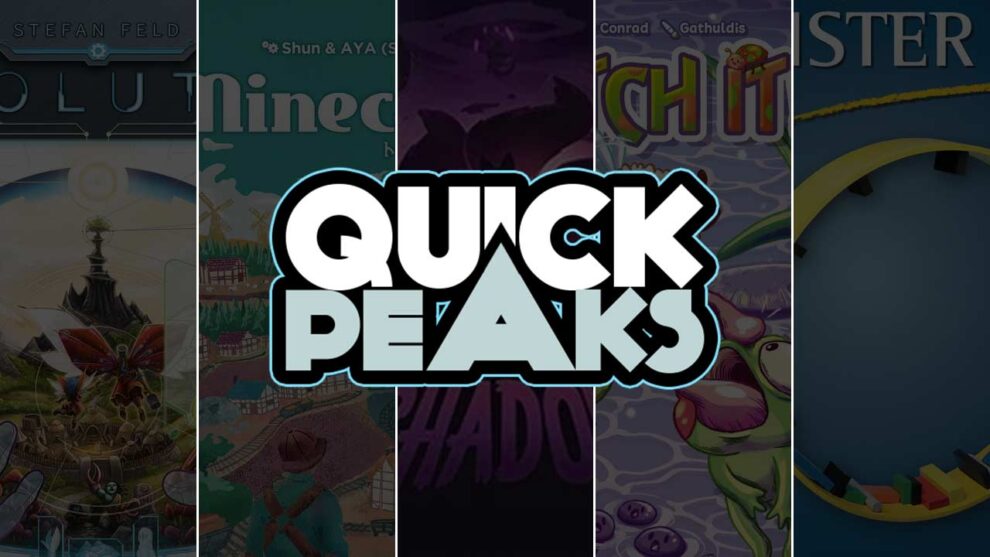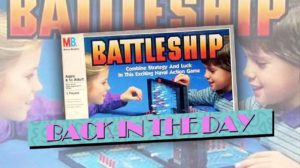Civolution – Justin Bell
I love coming back from SPIEL each year because many of my local Chicago friends bring home a ton of the hot new treasures they bought in Germany. At a recent gaming event, I plopped myself at the table where Stefan Feld’s new release Civolution was about to be taught because I was excited to give this one a spin. Then the teach started…and SIXTY-FIVE MINUTES later, we jumped into our play.
That teach was comically massive because Feld’s newest game is easily his heaviest, in terms of strategic decision making. I’m ready to say that “heavy” is not Feld’s lane. A civ-adjacent design, with tableau building technology cards, tracks, public goals, private goals, action selection, and map exploration, leads to a game with an unheard-of 32 different actions spread across each player’s personal board. Civolution is a dice game, meaning that this strategy game is really a dice-driven action selection design, which will rub many readers (and at least one of our writers!) the wrong way.
To Civolution’s credit, our playtime was just over two hours despite the hour-long teach, so at least the game didn’t take forever…but it never featured the kinds of interesting decisions I was hoping for. The best way I can summarize my time at the table came at the end of the first round, when I went to reach for my end-of-round income. “Actually, that symbol means you have to roll a die to see if you get that part of your income,” another player commented. I rolled a pink die to see if I even qualified for a single card draw…and failed the income check. Yes, Civolution is a heavy, dice-driven strategy Euro that even gates the simple process of getting your income to a die roll. Never again!
Ease of entry?:
★☆☆☆☆ – Rough
Would I play it again?:
☆☆☆☆☆ – No chance
Read more articles from Justin Bell.
Minecart Town – Andy Matthews
Jay Bernardo from Cardboard East has made it his goal to help promote board games from Asia (Japan, Singapore, Taiwan, Korea, etc.). He lived in Taiwan for over 15 years and while there he built up a following on his self-titled YouTube channel. That’s where I first saw mention of Minecart Town, from Jelly Jelly Jelly Games. If you know anything about me, you know I love a good tile laying game—and if it also includes city building and/or engine building, then I’m sold. Minecart Town has all three!
In Minecart Town you’ll try to build up the best town you can over the course of four rounds. Starting with just two buildings, your goal is to produce resources, construct train tracks to connect your buildings, transport goods around your town, and process low level goods into higher quality goods and/or victory points. This might sound easy but because of the order in which you do things, this is very much a “plan ahead” sort of game. In fact, after my first game I realized that while it makes sense to have a dense town, there’s good reasons to leave gaps here and there for buildings that come out later in the game.
Before getting to the 3rd and 4th rounds, I had a somewhat skeptical view of the game. But by the end, I was definitely sold on playing again in order to try out different strategies. Minecart Town recently completed a crowdfunding campaign, but you can likely late pledge on Kickstarter, or order directly from the publisher. The art is delightful, the gameplay is clever, and the game offers a fun optimization challenge for spatially minded players.
Ease of entry?:
★★★★☆ – The odd bump or two
Would I play it again?:
★★★★☆ – Would like to play it again
Read more articles from Andy Matthews.
Casting Shadows – K. David Ladage
It has been so long since I played a game that leans into the Ameritrash side of things that I had almost forgotten what it felt like to have player elimination. This was the first thing that bugged me in this little arena-style battle game. When my friend, Steve, was eliminated and we needed to continue on with him relegated to spectator, things felt wrong. Fortunately, this game is not very long.
Still, this is an interesting and fun little game! You have a character you are playing that is similar to the way a character in King of Tokyo is handled: you have a dial for your health, and a dial for your current shadow level (as opposed to points). Absorb enough shadow points and you can transform into your more powerful shadow-self which has its own unique ability. Unlike in King of Tokyo, there are no points in this game. This is a last-man-standing situation.
As you move around the seven-space board, you can collect spells and resources. If you have the right combination of resources, you can cast spells to injure your opponents. Collect counter-spells, and you can potentially stop or deflect or redirect other player’s spells. In the center of the map, there is a space where you can heal, but this is a small amount of healing and damage will be coming at you from all directions.
I will need a few more plays of this before I can say I can formulate a strategy. I say this because my wife won the first game we played by collecting counterspells and avoiding the other players. She let the rest of us fight until only one opponent remained, then smacked them a couple of times to win. Is this typical? Not sure. But it might be. And that would just be sad.
Ease of entry?:
★★★☆☆ – There were a few questions
Would I play it again?:
★★★★☆ – Would like to play it again
Read more articles from K. David Ladage.
Snatch it! – Justin Bell
I spent an afternoon recently with my kids playing the new “take that” family card robbing game Snatch it! (2024, HeidelBÄR and distributed in the US by Czech Games Edition). I thought the game would lead to at least a few scenes of sibling-on-sibling violence, because Snatch it! requires people to take cards from their tablemates pretty consistently during play.
But nothing of the sort happened. The game broke along two lines—my kids had a blast robbing their father (me) as they tried to build sets of cards that would score at the end of the game, and my wife and I couldn’t understand why the kids enjoyed the game! Using a strange “Pond Protocol” mechanic, Snatch it! looks like a ladder-climbing game because players try to claim cards from a “pond” in the center of the table by playing a matching card equal to or one digit higher than the card being eaten. Players can also snatch other cards in front of other players by using the same rules. A swarm card has a value that made it difficult to understand how someone could grab cards from time to time, so Snatch it! was a strangely hard game to teach, especially to my wife (a person who doesn’t usually struggle with game rules).
I’ll admit that clever play surfaced from time to time, spicing things up for me as my kids enjoyed slapping their cards down on the table to pretend that they were snatching up bugs. Scoring is straightforward and playtime is quick, about 20 minutes for a three- or four-player game. (The game can accommodate up to six players.) But the game didn’t have the wow I was hoping for, and my kids didn’t ask to play this game again in the days after we did our first two back-to-back plays…the sign of a game they enjoyed but would not revisit.
Ease of entry?:
★★★☆☆ – There were a few questions
Would I play it again?:
★★★☆☆ – Wouldn’t suggest it, but would happily play it
Read more articles from Justin Bell.
Hamster Roll – Andrew Lynch
When Zoch zum Spielen announced that Hamster Roll would come back into print, people got excited. Jacques Zeimet’s dexterity game has its fans, mostly, I have to imagine, on account of its novelty. The centerpiece of Hamster Roll is a giant, wooden wheel, with a series of short shelves lining the inside wall. Players take turns adding one of their own wooden pieces, being sure always to place their piece further along the wheel than the previous piece. If pieces fall off during your turn, you have to pick them up.
I had high expectations. I thought Hamster Wheel, beloved as it is in certain circles, would offer something unique. Instead, it fell pretty flat. Having now played a few times, there’s just not much going on. Dexterity games of this ilk are often light on gameplay. The joy of something like Tinderblox comes from laughing as you and your friends fail. The failures in Hamster Wheel are not exciting enough, and the successes pass by without notice. The wheel may be large, but the game itself falls flat.
Ease of entry?:
★★★★★ – No sweat
Would I play it again?:
★★☆☆☆ – Would play again but would rather play something else














Add Comment